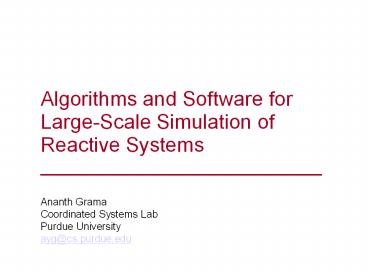Algorithms and Software for Large-Scale Simulation of - PowerPoint PPT Presentation
Title:
Algorithms and Software for Large-Scale Simulation of
Description:
model chemical reactions. ReaX force field postulates a classical bond order ... Reactive and non-reactive MD simulations on 131K BG/L processors. ... – PowerPoint PPT presentation
Number of Views:151
Avg rating:3.0/5.0
Title: Algorithms and Software for Large-Scale Simulation of
1
Algorithms and Software for Large-Scale
Simulation of Reactive Systems ___________________
____________ Ananth Grama Coordinated Systems
Lab Purdue University ayg_at_cs.purdue.edu
2
Molecular Simulation Methods
- Ab-initio methods (few approximations but slow)
- DFT
- CPMD
- Electron and nuclei treated explicitly
- Classical atomistic methods (more
approximations) - Classical molecular dynamics
- Monte Carlo
- Brownian dynamics
- No electronic degrees of freedom. Electrons are
- approximated through fixed partial charges on
atoms. - Continuum methods (no atomistic details)
3
Statistical and continuum methods
4
Simplified Interactions in Classical MD
Simulations
V Vbond Vangle Vdihedral VLJ
VElecrostatics
5
Implementation of Classical Interactions
- Molecular topologies are fixed, so bonded
interactions are - implemented as static neighbor lists
- Non-bonded interactions are implemented as
dynamic - neighbor lists
- Usually not updated at every time step
- Only two body interactions, so relatively easy
to implement.
6
Reactive systems
- Chemical reactions correspond to association and
dissociation of chemical bonds - Classical simulations cannot simulate reactions
- ab-initio methods calculate overlap of electron
orbitals to - model chemical reactions
- ReaX force field postulates a classical bond
order - interaction to mimic the association and
dissociation of - chemical bonds1
1 van Duin et al , J. Phys. Chem. A, 105, 9396
(2001)
7
Bond order interaction
- Uncorrected bond order
- Where ??is for
- ??????????and?????bonds?
- The total uncorrected bond order is sum of three
types of bonds - Bond order requires correction to account for
the correct valency
1 van Duin et al , J. Phys. Chem. A, 105, 9396
(2001)
8
Bond Order Interaction
- Upon correction, the bond order between a pair
of atoms depends on the uncorrected bond orders
of the neighbors of each atoms - The bond orders rapidly decay to zero as a
function of distance so it is reasonable to
construct a neighbor list for efficient
computation of bond orders
9
Neighbor Lists for Bond Order
- Efficient implementation critical for
performance - Implementation based on an oct-tree
decomposition of the domain - For each particle, we traverse down to
neighboring octs and collect neighboring atoms - Has implications for parallelism (issues
identical to parallelizing multipole methods)
10
Bond Order Choline
11
Bond Order Benzene
12
Other Local Energy Terms
- Other interaction terms common to classical
simulations, e.g., bond energy, valence angle and
torsion, are appropriately modified and
contribute to non-zero bond order pairs of atoms - These terms also become many body interactions
as bond order itself depends on the neighbors and
neighbors neighbors - Due to variable bond structure there are other
interaction terms, such as over/under
coordination energy, lone pair interaction, 3 and
4 body conjugation, and three body penalty energy
13
Non Bonded van der Waals Interaction
- The van der Waals interactions are modeled using
distance corrected Morse potential - Where R(rij) is the shielded distance given by
14
Electrostatics
- Shielded electrostatic interaction is used to
account for orbital overlap of electrons at
closer distances - Long range electrostatics interactions are
handled using the Fast Multipole Method (FMM).
15
Charge Equilibration (QEq) Method
- The fixed partial charge model used in classical
simulations is inadequate for reacting systems. - One must compute the partial charges on atoms at
each time step using an ab-initio method. - We compute the partial charges on atoms at each
time step using a simplified approach call the
Qeq method.
16
Charge Equilibration (QEq) Method
- Expand electrostatic energy as a Taylor series
in charge around neutral charge. - Identify the term linear in charge as
electronegativity of the atom and the quadratic
term as electrostatic potential and self energy. - Using these, solve for self-term of partial
derivative of electrostatic energy.
17
Qeq Method
- We need to minimize
- subject to
where
18
Qeq Method
19
Qeq Method
From charge neutrality, we get
20
Qeq Method
Let
where
or
21
Qeq Method
- Substituting back, we get
We need to solve 2n equations with kernel H for
si and ti.
22
Qeq Method
- Observations
- H is dense.
- The diagonal term is Ji
- The shielding term is short-range
- Long range behavior of the kernel is 1/r
23
Implementation, Performance, and Validation
24
Serial Performance Scaling
25
Parallel Performance
Reactive and non-reactive MD simulations on 131K
BG/L processors. Total execution time per MD step
as a function of the number of atoms for 3
algorithms QMMD, ReaxFF,conventional MD
Goddard, Vashistha, Grama
26
Parallel Performance
Total execution (circles) and communication
(squares) times per MD time for the ReaxFF MD
with scaled workloads36,288 x p atom RDX systems
(p 1,..,1920).
27
Current Development Efforts
- Development and validation of parallel version
of next generation Reax code. - Integration into LAMMPS.
28
Planned Development Efforts
- Interface with conventional MD
- Interface with continuum models
- Validation in the context of surface contact for
RF MEMS device






























